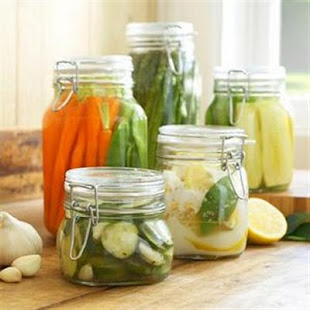8.10.2009
goat's milk
dozen and half eggs
2 quarts Nickel fillet green bush beans
6 very large golden beets
1 small Stupice tomato
3 pints everbearing raspberries
2 pints wild blackberries
2 average zucchini
more cucumbers as well as a few slicing cucumbers
2 very large heads Broccoli
8.9.2009
goat's milk
8.8.2009
more cucumbers - too many to keep track of any more
small handful of first green pole beans
3 small tomatoes
more wild blackberries - just enough for milkshakes
8.7.2009
goat's milk
8.6.2009
goat's milk
1 pints raspberries - fall crop coming on strong
1 cup of final marionberries
3 small Stupice tomatoes - all that's been ready yet
8 Orient Express cucumbers
3 good sized zucchini but still manageable
8.5.2009
goat's milk
pint of wild blackberries
picked final batch of Santa Rosa plums
8.4.2009
goat's milk
dozen eggs or so
small bunch golden beets
large batch green bush beans - a little big - should've been picked before we returned from trip
basket of Santa Rosa plums
8.3.2009
goats milk
large bunch basil for making pesto
2 lbs. red raspberries
2 small heads bok choi
1 bunch spinach
2 lbs. Marionberries
radishes and bok choi that had gone to seed were pulled and composted
armfuls of zucchini that had escaped my daughter's eye while we were out of town
20 or so Orient Express burpless cucumbers
6 slicing cucumbers
Due to extended vacation, there are no postings in this date range. Our daughter picked far more zuch's and cucumbers than she could use however.
7.23.2009
goat milk
4 cucumbers
3 zucchini
7.22.2009
1 1/2 lbs red raspberries
3 lbs. marionberries
goat milk
7.21.2009
dozen eggs
goat milk
4 side shoots of broccoli
9 cucumbers
5 zucchini
bunch radishes
cinnamon, sweet, thai, and lime basil
3 head pac choi chinese greens
4 lbs. red raspberries
3 1/2 lbs. marionberries
7.18.2009
3 1/2 lbs. marionberries
1 1/2 lbs. raspberries
1 head Romain lettuce
goat milk
7.15.2009
4 cucumbers
1 zuchinni
2 gallons goat milk
7.14.2009
2 stalks broccoli from side shoots
3 lbs. mixed raspberries, black cap raspberries, marionberries
1 head bibb lettuce
1 head cabbage
2 gallons goat milk
7.13.2009
1 zuchinni
3 cucumbers
2 gallons goat milk
3 lbs. marionberries
2 lbs. red everbearing raspberries
4 lbs. Montmorency pie cherries
7.11.2009
2 gallons goat milk
3 lbs. marionberries
1 1/2 lbs. blueberries
2 zuchinni
3 cucumbers
1 bunch radishes
7.10.2009
2 gallons goat milk
2 lbs. red everbearing raspberries
small basket snow peas
7.9.2009
basket of first ripe marrionberries
6 lbs. Montmorency pie cherries
2 gallons goat milk
7.8.2009
1 head broccoli
2 cups black cap raspberries
2 quarts red everbearing raspberries
1 bunch radishes
5 burpless cucumbers
1 zucchini
2 cups snap peas - pretty much last of harvest
dozen eggs
5 quarts goat milk - now milking additional does since all kids now weaned
7.7.2009
too busy with family to do hardly more than get watering done
3 quarts goat milk
7.6.2009
1 zucchini
1 head broccoli
2 burpless cucumbers - 'Orient Express'
3 lbs. Montmorency pie cherries
3 lbs. Rainier sweet cherries
3 quarts goat milk
7.5.2009
no harvest
3 quarts goat milk
7.4.2009
3 quarts goat milk
4 heads Chinese cabbage - nice large ones
4 head Bibb lettuce - just about ready to bolt in heat
5 lbs. Montmorency sour cherries
10 lbs. Rainer sweet cherries
7.3.2009
3 quarts goat milk
1 pt early raspberries
large bowl snow peas
8 bunches spinach - just about ready to bolt in heat
7.2.2009
3 quarts goat milk
gathered dozen eggs
plenty to harvest - but alas, no time toay. check
daily journal for today and you'll see why.
7.1.2009
9 lbs. Montmorency pie cherries
3 lbs. Rainier sweet cherries
1 bunch red and yellow beets
cilantro
3 quarts goat milk
6.30.2009
3 cups sour Montmorency pie cherries
1 zucchini
2 heads Bibb lettuce
1 head Romain lettuce
spinach leaf thinnings
3 quarts goat milk

.jpg)
.jpg)
.jpg)








.JPG)
.JPG)
.JPG)
.JPG)
.JPG)
.JPG)
.JPG)
.JPG)
.JPG)
.JPG)
.JPG)
.JPG)
.JPG)
.JPG)
.JPG)
.JPG)
.JPG)
.JPG)
.JPG)
.JPG)
.JPG)






.JPG)
.JPG)
.JPG)


.JPG)
.JPG)






.jpg)



.jpg)


